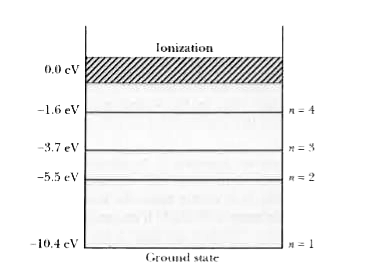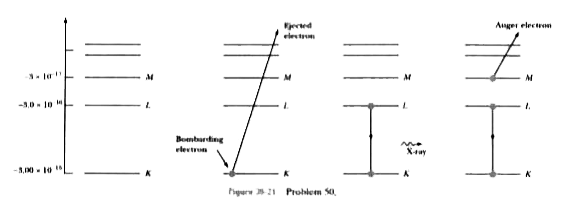PROBLEMS from RESNICK AND HALLIDAY PHYSICS (HINGLISH) ALL ABOUT ATOMS for Class 12
| Class 12 | PHYSICS |
| Chapter | ALL ABOUT ATOMS |
| RESNICK AND HALLIDAY PHYSICS (HINGLISH) | PROBLEMS |
| Medium | English |
| Academic Year | 2023-2024 |
Question 2
A hypothetical atom has only two atomic energy levels, separated by 3.2 eV. Suppose that at a certain altitude in the atmosphere of a star there are 6.1×1013/cm3 of these atoms in the higher-energy state and are 2.2×1015/cm3 in the lower-energy state. What is the temperature of the star's atmosphere at that altitude? View SolutionQuestion 3
Suppose two electrons in an atom have quantum numbers n=2 and l=1. (a) How many states are possible for those two electrons? (Keep in mind that the electrons are indistinguishable). (b) If the Pauli exclusion principle did not apply to the electrons, how many states would be possible? View SolutionQuestion 6
A tungsten (Z=74) target is bombarded by electrons in an x-ray tube. The K, L and M energy levels for tungsten have the energies 69.5, 11.3, and 2.30 ke V, respectively. (a) What is the minimum value of the accelerating potential that will permit the production of the characteristic KαandKβ lines of tungsten? (b) For this same accelerating potential, what is λmin? What are the (c ) Kα and (d) Kbet wavelengths? View SolutionQuestion 7
A high-powered laser beam (λ=600nm) with a beam diameter of 10 cm is aimed at the Moon, 3.8×105km distant. The beam spreads only because of diffraction. The angular location of the edge of the central diffraction disk is given by
sinθ=1.22λd,
where d is the diameter of the beam aperture. What is the diameter of the central diffraction disk on the Moon's surface? View SolutionQuestion 9
Consider the elements selenium (Z=34), bromine (Z=35), and krypton (Z=36). In their part of the periodic table, the subshells of the electronic states are filled in the sequence.
1s2s2p3s3p3d4s4p……
What are (a) the highest occupied subshell for selenium and (b) the number of electrons in it, (c ) the highest occupied subshell for bromine and (d) the number of electrons in it, and (e) the highest occupied subshell for krypton and (f) the number of electrons in it? View SolutionQuestion 12
The x rays shown are produced when 35.0 ke V electrons strike a molybdenum (Z=42) target. If the accelerating potential is maintained at this value but a silver (Z=47) target is used instead, what values of (a) λmin, (b) the wavelength of the Kα line, and (c ) the wavelength of the Kβ line result? The K, L, and M atomic x-ray levels for silver are 25.51, 3.56, and 0.53 keV. View SolutionQuestion 15
A population inversion for two energy levels is often described by assigning a negative Kelvin temperature to the system. What negative temperature would describe a system in which the population of the upper energy level exceeds that of the lower level by 10% and the energy difference between the two levels is 2.32 eV? View SolutionQuestion 20
A hypothetical atom has two energy levels, with a transition wavelength between them of 580 nm. In a particular sample at 300 K, 4.0×1020 such atoms are in the state of lower energy. (a) How many atoms are in the upper state, assuming conditions of thermal equilibrium? (b) Suppose, instead, that 3.0×1020 of these atoms are ''pumped'' into the upper state by an external process, with 1.0×1020 atoms remaining in the lower state.
View SolutionQuestion 22
X rays are produced in an x-ray tube by electrons accelerated through an electric potential difference of 50.0 kV. Let K0 be the kinetic energy of an electron at the end of the acceleration. The electron collides with a target nucleus (assume the nucleus remains stationary) and then has kinetic energy K1=0.500K0. (a) What wavelength is associated with the photon that is emitted? The electron collides with another target nucleus (assume it, too, remain stationary) and then has kinetic energy K2=0.500K1. (b) What wavelength is associated with the photon that is emitted? View SolutionQuestion 23
Assume that lasers are available whose wavelengths can be precisely ''tuned'' to anywhere in the visible range-that is, in the range 450nm<λ<650nm. If every television channel occupies a bandwidth of 10 MHz, how many channels can be accommodated within this wavelength range? View SolutionQuestion 32
Ruby lases at a wavelength of 694 nm. A certain ruby crystal has 4.00×1019Cr ions (which are the atoms that lase). The lasing transition is between the first excited state and the ground state, and the output is a light pulse lasting 1.50μs. As the pulse begins, 60.0% of the Cr ions are in the first excited state and the rest are in the ground state. What is the average power emitted during the pulse? View SolutionQuestion 36
An electron is in a state with l=3, (a) What multiple of h gives the magnitude of →L? (b) What multiple of μB gives the magnitude of →μ? (c ) What is the largest possible value of ml? (d) what multiple of h gives the corresponding value of Lz, and (e) what multiple of μB gives the corresponding value of μorb,z? (f) What is the value of the semiclassical angle θ between the direction of Lzand→L? What is the value of angle θ for (g) the second largest possible value of ml and (h) the smallest (that is, most negative) possible value of ml? View SolutionQuestion 37
When electrons bombard a molybdenum target, they produce both continuous and characteristic x rays as shown in fig. In that figure the kinetic energy of the incident electrons is 35.0 keV, (a) what is the value of λmin, and (b) do the wavelengths of the KαandKβ lines increase, decrease, or remain the same? View SolutionQuestion 41
The active medium in a particular laser that generates laser light at a wavelength of 694 nm is 6.00 cm long and 1.00 cm in diameter. (a) Treat the medium as an optical resonance cavity analogous to a closed organ pipe. How many standingwave nodes are there along the laser axis? (b) By what amount Δf would the beam frequency have to shift to increase of the travel by one? (c ) Show that Δf is just the inverse of the travel time of laser light for one round trip back and forth along the laser axis. (d) What is the corresponding fractional frequency shift Δf/f? The appropriate index of refraction of the lasing medium (a ruby crystal) is 1.75. View SolutionQuestion 44
Fig shows that energy levels of a mercury atom. Electrons with kinetic energies of 7.0 eV are introduced into mercury vapor. (a) Convert the energy levels to the system that sets the ground state at 0 eV. (b) What is the kinetic energy of an electron after an elastic collision with a mercury atom? (c ) What are the possible kinetic energies of an electron after an inelastic collision with a mercury atom? (d) What are the energies of the photons coming from the mercury vapor?
 View Solution
View SolutionQuestion 46
An imaginaryy atom whose energy levels are shown here undergoes an Auger transition. This implies that the x-ray photon emitted during transition from L to K state is absorbed by another electron in M shell and it comes out of the atom. Calculate the initial energy of the Auger electron as in fig.
 View Solution
View SolutionQuestion 47
(a) Find the energy in electron volts required to strip a calcium atom (Z=20) of its last electron, assuming the other 19 have been removed. How does this compare with the energy required to excite the Kα x-ray lines of Ca, which is about 3.7 keV? (b) Why there is a difference? View Solution
